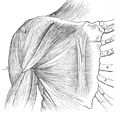| Sternalis | |
|---|---|
 Sternalis muscle, in line with rectus abdominis and sternomastoid, was found in 6% of 535 cadavera (R. N. Barlow) | |
| Details | |
| Origin | Manubrium of sternum or clavicle |
| Insertion | Xiphoid process, pectoral fascia, lower ribs, costal cartilages or rectus sheath |
| Identifiers | |
| Latin | musculus sternalis |
| TA98 | A04.4.01.001 |
| TA2 | 2300 |
| FMA | 9717 |
| Anatomical terms of muscle | |
The rectus sternalis muscle is an anatomical variation that lies in front of the sternal end of the pectoralis major parallel to the margin of the sternum. The sternalis muscle may be a variation of the pectoralis major or of the rectus abdominis.



